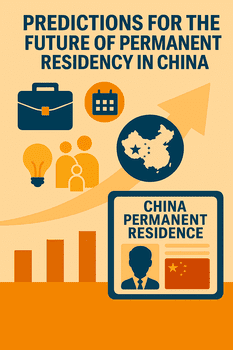
China’s permanent residency system, commonly known as the “Chinese Green Card,” remains one of the world’s most exclusive immigration pathways.
With only about 1,500 green cards granted annually despite nearly 846,000 foreigners living in mainland China according to the 2020 national census, the system is notoriously selective.
However, recent policy developments and economic priorities suggest potential changes on the horizon.
This evidence-based analysis explores realistic predictions for China’s permanent residency system over the next five years.
Current State of China’s Permanent Residency System
Before examining future trends, it’s essential to understand the current landscape.
China’s permanent residency system underwent significant changes in recent years, including the introduction of the upgraded “Five-star Card” in December 2023, which enhanced security features and functionality for foreign permanent residents (SJ Grand, 2025).
Current approval requirements vary by category and region, with particularly stringent criteria for employment-based applications:
| Category | Key Requirements (2025) | Regional Variations |
|---|---|---|
| Employment-Based | • Shanghai: Annual salary ≥ CNY 886,104• Annual IIT payment ≥ CNY 177,221• 4 consecutive years working in China• Minimum 6 months/year in mainland China | Beijing and Guangzhou have similar but slightly lower thresholds |
| Investment-Based | • Western regions: USD 500,000• Central regions: USD 1 million• Eastern regions: USD 2 million | Special economic zones may offer more favorable terms |
| Marriage-Based | • 5+ years married to Chinese citizen• 5 consecutive years in China (≥9 months/year)• Stable income and accommodation | Implementation varies by province |
| Talent-Based | • Outstanding contributions to China• Expertise in priority fields• Recommendation from relevant authorities | Tier-1 cities have more established talent programs |
Source: Immigration to China, 2024
Evidence-Based Predictions for 2025-2030
1. Targeted Expansion for Strategic Talent
Current Evidence: China’s 14th Five-Year Plan (2021-2025) emphasizes self-reliance in science and technology, identifying key sectors including artificial intelligence, quantum computing, semiconductors, and biotechnology as national priorities.
Expert Insight: “China is likely to create more specialized PR pathways for experts in strategic industries while maintaining overall selectivity,” notes Dr. Wang Huiyao, President of the Center for China and Globalization (CCG). “The focus will be quality over quantity, with streamlined processes for individuals who directly support national development goals.”
Prediction Timeline:
- 2025-2026: Introduction of specialized PR tracks for experts in semiconductor technology, AI, and biotechnology
- 2027-2028: Expansion to include additional strategic sectors identified in the 15th Five-Year Plan
2. Regional Differentiation Will Intensify
Current Evidence: China’s regional development strategy has already created significant variations in PR implementation. Shanghai’s 2023 “International Talent Highland” initiative introduced city-specific benefits for high-level foreign experts, while the Greater Bay Area offers unique immigration advantages.
Statistical Support: According to the National Immigration Administration, 83% of permanent residency cards issued in 2024 were concentrated in just six regions: Shanghai, Beijing, Guangdong, Jiangsu, Zhejiang, and the Greater Bay Area.
Prediction: Regional differentiation will accelerate, with tier-1 and tier-2 cities developing increasingly distinct PR programs aligned with local economic priorities. By 2027, we may see up to 10 different regional PR schemes with varying requirements and benefits.
| Region | Predicted Focus | Potential Benefits |
|---|---|---|
| Shanghai/Beijing | Global financial talent, R&D leaders | Expedited processing, tax incentives |
| Greater Bay Area | Tech entrepreneurs, advanced manufacturing | Lower investment thresholds, innovation subsidies |
| Western Regions | Sustainable development, education | Reduced requirements, housing allowances |
| Free Trade Zones | International trade, logistics | Simplified procedures, business incentives |
3. Digital Transformation of the Application Process
Current Evidence: China’s 2023 “Digital Government” initiative aims to digitize 90% of administrative processes by 2027. The National Immigration Administration has already implemented biometric verification and online appointment systems.
Expert Insight: “The PR application process will become increasingly digital, reducing processing times and improving transparency,” predicts Zhang Wei, immigration attorney at Global Migration Law Group. “However, in-person interviews and security checks will remain mandatory elements.”
Realistic Timeline:
- 2025: Comprehensive online application platform with real-time status tracking
- 2026-2027: AI-assisted preliminary application screening
- 2028: Partial integration with China’s digital identity system
4. Modest Expansion of Family Reunification Pathways
Current Evidence: China’s 2021 census revealed accelerating population aging, with those aged 60+ increasing to 18.7% of the population. The 2023 draft amendments to the Regulations on Permanent Residence of Foreigners included provisions for elderly parents of PR holders.
Statistical Context: Family-based PR approvals increased by 14% between 2022-2024, according to data from the National Immigration Administration, though from a very small base.
Prediction: Family reunification policies will see modest liberalization, particularly for:
- Spouses of Chinese citizens (reduced waiting period from 5 to 3-4 years)
- Minor children of PR holders (simplified procedures)
- Elderly parents of PR holders (new conditional residency options)
5. Integration Requirements Will Become More Formalized
Current Evidence: Recent research indicates that “insufficient integration into Chinese society” is a common reason for PR application denial, with officials specifically citing limited language proficiency and minimal cultural understanding (PMC, 2022).
Expert Insight: “China is moving toward more formalized integration requirements similar to those in countries like Germany and Canada,” observes Dr. Liu Guofu, immigration law professor at Beijing Institute of Technology. “We can expect standardized language proficiency requirements and civic knowledge assessments within the next five years.”
Prediction: By 2027, PR applications will likely include:
- Mandatory HSK language testing (likely HSK 3-4 level)
- Basic knowledge test on Chinese laws and social norms
- Documentation of community involvement
6. Entrepreneurship Pathways Will Evolve, Not Revolutionize
Current Evidence: China’s 2023 “Innovation-Driven Development Strategy” emphasizes attracting foreign entrepreneurs, particularly in emerging technologies. Several pilot programs in Shanghai and Shenzhen have tested modified investment requirements for tech startups.
Expert Insight: “China will likely introduce more flexible investment thresholds for technology entrepreneurs, but comprehensive evaluation of business viability will remain central,” says Li Feng, Director of International Business at the Shanghai Free Trade Zone. “The focus will be on quality of innovation rather than simply lowering financial barriers.”
Prediction: By 2026-2027, expect:
- Alternative qualification pathways for tech entrepreneurs with proven innovation potential
- Partial substitution of capital requirements with patents, intellectual property, or proven business models
- Incubator-linked PR pathways in select innovation hubs
Practical Implications for Prospective Applicants
For foreigners considering long-term residence in China, these predictions suggest several practical strategies:
- Skill Development in Priority Sectors: Focus on developing expertise in China’s strategic industries identified in the Five-Year Plans.
- Regional Strategy: Consider positions in regions with more favorable PR policies aligned with your profile.
- Cultural Integration: Invest in Mandarin language skills and cultural knowledge, as these will likely become formal requirements.
- Digital Preparation: Maintain comprehensive digital records of achievements, tax payments, and contributions to facilitate future applications.
- Stay Informed: Monitor policy developments through official channels like the National Immigration Administration and professional organizations such as the China-Britain Business Council.
Conclusion: Evolution, Not Revolution
China’s permanent residency system will likely evolve incrementally rather than undergo radical transformation.
The system will remain selective, with changes targeted at attracting strategic talent while maintaining robust security measures.
Regional differentiation will offer varied opportunities, while digital transformation will improve process efficiency.
For qualified individuals in priority sectors, the path to permanent residency may become more navigable, but China will continue to maintain one of the world’s most selective immigration systems, reflecting its unique approach to managed international talent integration.
Resources for Staying Updated:
- National Immigration Administration – Official updates on immigration policies
- China Law Translate – English translations of Chinese legal developments
- IkkyInChina – Practical guides for expats navigating Chinese immigration
- Center for China and Globalization – Research on China’s global talent policies


